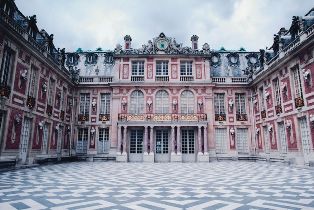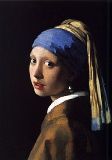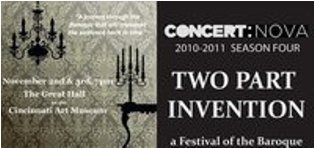
What's Baroque?
This is baroque:

Marble Court, Palace of Versailles, France
|
This is baroque:

"The Girl with the Pearl Earring" by Johannes Vermeer
|

|
The chamber ensemble concert:nova presents “Two-Part Invention: A Festival of the Baroque," with commentary by musicologist Bruce McClung of the University of Cincinnati College-Conservatory of Music.
The program comprises works by baroque all-stars Johann Sebastian Bach, Antonio Vivaldi, Jean-Philippe Rameau, George Frederic Handel, Georg Philip Telemann and Tomasso Albinoni. Bringing the baroque style into the present will be works by Igor Stravinsky and Samuel Barber.
Performers include flutist Randolph Bowman, oboist Dwight Parry, violinists Mauricio Aguiar, Tatiana Berman, Gabriel Pegis and Anna Reider, all members of c:n; with guest artists Vivian Montgomery on harpsichord, and Robert Sullivan and Douglas Lindsay on trumpet.
The baroque period in music, which reflected the painting, sculpture, architecture and history of its time, has been roughly demarcated 1600-1750, i.e. from the publication of the oldest surviving opera, Italian composer Jacopo Perio’s “L’Euridice,” until the death of Bach.

detail from Rembrandt
|
The adoption of tonality, i.e. major and minor keys, became the rule for the next 300 years (give or take a century). The baroque era also saw the rise of the oratorio (in effect, sacred opera) and the concerto and sonata forms (solo instruments and accompaniment). Instrumental as opposed to purely vocal music grew exponentially. Ornamentation and improvisation became important components of performance technique, and overall levels of virtuosity increased.
Both evenings will begin with keyboard music by Bach from his Two and Three-Part Inventions (two and three-part counterpoint). There will be concertos by Bach and Vivaldi, with Bach’s Brandenburg Concertos No. 2 and 3, and Vivaldi’s Concerto for Oboe and Violin. The famous Largo from Handel’s oratorio “Xerxes” will be heard Nov. 3.
Representing the 20th century will be selections from Stravinsky's "Pulcinella" Suite and Barber’s 1944 “Capricorn” Concerto for Flute, Trumpet, Oboe and Strings.
Concerts are at 7 p.m. November 2 and 3 in the Great Hall at the Cincinnati Art Museum. Tickets are $40 for both concerts, $25 for students; $25 for one concert, $15 for students. Call (513) 721-ARTS or purchase online at http://www.concertnova.com
“Two-Part Invention: A Festival of the Baroque"
Part One, Nov. 2.
J.S. Bach. Selections from Two-Part Inventions.
J.S. Bach, Selections from Three-Part Inventions.
Rameau.
“Pieces de Clavecin," No. 5.
Vivaldi. Concerto for Oboe and Violin.
Bach, "Brandenburg" Concerto No. 3.
Stravinsky, Selections from "Pulcinella" Suite.
Bach, Arioso from Cantata No. 156.
Part Two. Nov. 3.
Bach, Selections from Two-Part Inventions.
Bach, Selections from Three-Part Inventions.
Telemann, Paris Quartet No. 12.
Albinoni, Sinfonia in G Major for Strings.
Bach, "Brandenburg" Concerto No. 2.
Barber, “Capricorn” Concerto.
Handel, Largo from “Xerxes” for strings and winds.